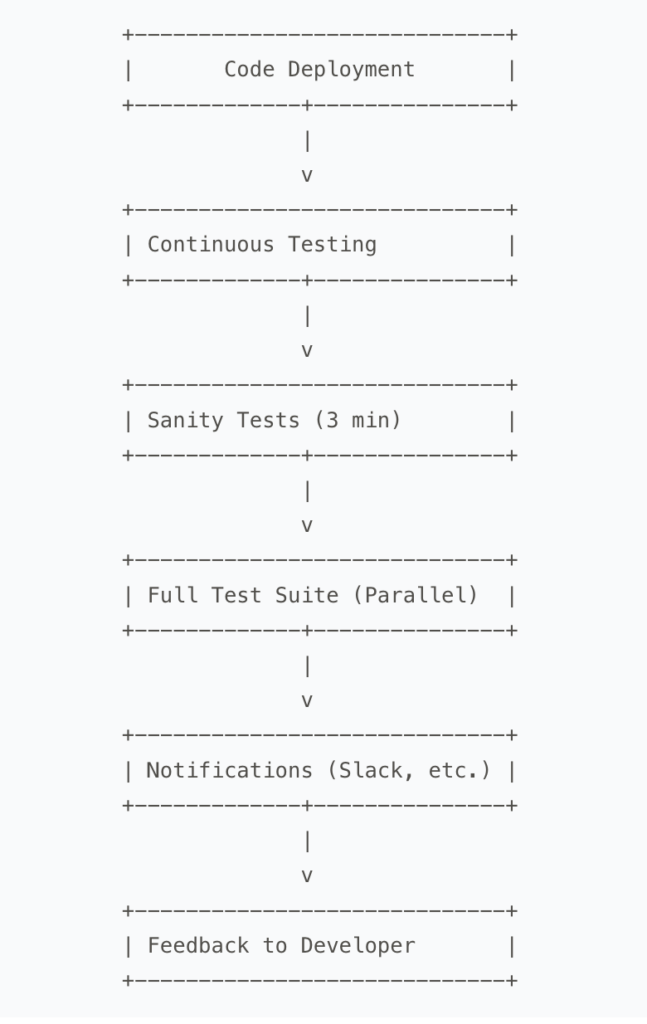
Imagine you’re in a fast-paced kitchen: the orders keep coming in, and the chef is preparing dish after dish, but there’s no one tasting them before they go out. What if the soup is too salty? What if the pasta is undercooked? Without quick feedback—someone tasting and giving feedback before it reaches the customer—dishes can easily end up not meeting standards.
In the world of software development, the chef is the developer, and the “taste test” is software testing. If developers make changes to the code (the recipe) and it’s deployed (sent out) without quick feedback loop, it could lead to poor-quality “dishes” (features) reaching users.
This is why the 15-Minute Feedback Loop in software testing is so essential. It’s a way for QA to “taste test” the product within 15 minutes of code deployment, ensuring that issues are caught and corrected early.
Follow on LinkedInWhat is the 15-Minute Feedback Loop in software testing?
In fast-moving industries like quick-commerce, companies like food delivery apps aim to deliver within 10 minutes. Similarly, in agile software development, QA teams aim to give feedback within 15 minutes after code is deployed to the staging or production environment. This is no longer just a “nice-to-have”—it’s a must-have in environments where development cycles are rapid.
Let’s break down why this is so crucial.
Enjoying this? Our subscribers receive full access to our premium blogs and useful resources right in their inbox. Be a part of our insider community of 3,000+ readers. Join us now!
Why Quick Testing Feedback is Crucial
In modern software development, there’s often pressure to release new features and updates quickly. This speed is only sustainable if QA teams can give fast feedback to ensure quality. Here’s why a quick feedback loop is essential:
- Fail Fast, Repair Fast: The sooner we identify an issue, the quicker we can fix it. If we wait too long, issues might reach users and harm their experience.
- Supports Frequent Deployments: Many teams release code multiple times a day. Fast feedback ensures each release maintains quality without requiring lengthy testing cycles.
- Promotes a Culture of Accountability: Developers know they’ll get rapid feedback, so they are motivated to write higher-quality code from the start.
- Reduces Reliance on Manual Testing: By automating feedback, teams reduce the need for time-consuming manual testing, focusing on more strategic activities.

How to Build a 15-Minute Testing Feedback Ecosystem
Achieving a 15-minute feedback loop in software testing doesn’t happen overnight, but with the right practices, it’s possible. Here’s a step-by-step approach to building this ecosystem:
1. Implement Continuous Testing
Continuous Testing ensures that testing is integrated into every stage of development. Every time developers push code changes, automated tests run immediately. Here’s the basic flow:
Code Change -> Automated Tests Triggered -> Results Shared -> Developer FeedbackAutomated tests are integrated into the CI/CD pipeline, ensuring they run as soon as new code is pushed.
2. Automate Test Result Notifications
Once automated tests are executed, the results need to be quickly shared with all relevant stakeholders. This can be done by setting up notifications on platforms like Slack, Teams, or email. Immediate feedback drives quicker actions, creating a sense of urgency to resolve issues quickly.

3. Parallelize Test Execution
One of the keys to achieving quick feedback is to run tests in parallel. Instead of running test cases one after another, we can split up tests into groups and run them at the same time. This drastically reduces overall testing time.
In addition to running individual tests in parallel, you can run different test suites in parallel. For example, while running your Sanity Tests, you could simultaneously execute a Functional Test Suite, reducing the time spent on testing and improving overall efficiency.
4. Organize Tests into Multiple Levels
Organising test suites into levels helps prioritise which tests should run first. This is especially important when time is critical.
- Sanity Tests: These are quick, high-priority tests that ensure core functions are working as expected. If these pass, it’s a good sign that the build is stable.
- Full Test Suites: After sanity checks, more comprehensive tests covering additional functionality can continue in parallel or after the quick tests have finished.

This layered approach ensures major issues are caught early, while in-depth tests run in the background.
5. Write Cross-Environment Test Cases
Writing tests that work across multiple environments (e.g., both staging and production) ensures that tests are not bottlenecked by environment-specific issues. Cross-environment tests also help reduce redundant tests and improve test efficiency.
6. Support Multiple Repositories in Distributed Systems
In distributed architectures, different components are often deployed across separate systems and housed in distinct repositories. For example, the backend API and frontend UI might each have their own repositories and deployment environments. Ensuring that your testing framework supports integration across multiple repositories and deployments is essential for simultaneously testing all components within the system.
Visualising the 15-Minute Feedback System in Action
To put it all together, here’s an end-to-end view of the 15-minute feedback loop:

In this architecture, different test suites (Sanity, Functional, etc.) are run in parallel, ensuring that feedback is provided quickly while covering all critical aspects of the application.
Benefits of Achieving a 15-Minute Feedback Loop
When this system is fully operational, your QA teams can achieve:
- Quick Issue Detection: Bugs and issues are caught and reported within minutes of deployment.
- High-Quality Releases: Rapid feedback enables frequent releases without sacrificing quality.
- Better Collaboration: QA, developers, and stakeholders stay aligned through automated notifications and fast feedback.
- More Time for Value-Added Tasks: With reduced manual testing, QA teams can focus on higher-value activities like exploratory testing or test strategy optimisation.
Known Challenges and Bottlenecks
Despite its advantages, implementing a 15-minute feedback loop can be challenging:
- Infrastructure Costs: Setting up parallel test execution and maintaining CI/CD pipelines can be resource-intensive.
- Flaky Tests: Unreliable tests slow down feedback and undermine trust in the automation.
- Coordination with Multiple Teams: In distributed systems, managing changes across multiple teams can be complex.
- Initial Setup Time: Developing comprehensive test suites and configuring pipelines can require a significant initial investment.
Gradual Steps to Move Toward the 15-Minute Feedback Goal
Building a 15-minute feedback loop requires incremental changes. Here’s how to get started:
- Automate Core Tests: Start by automating your most critical tests, such as sanity or smoke tests.
- Enable Parallel Execution Gradually: Start with small, manageable test groups and move toward larger test suites in parallel.
- Optimize Test Infrastructure: Use cloud-based solutions or containerized environments to scale testing resources as needed.
- Iterate on Test Suites: Regularly review and update test cases to ensure they are effective and up to date with code changes.
Conclusion
Achieving a 15-minute feedback cycle is an invaluable approach to maintaining high quality while delivering software quickly. By adopting continuous testing, parallelizing test execution (both test cases and entire suites), automating notifications, and organizing tests into levels, QA teams can provide feedback that leads to faster, more reliable releases. With a culture of rapid testing and continuous improvement, development teams can focus on creating high-quality features while maintaining speed and efficiency.
For freshers in QA, remember that every step toward improving testing practices contributes to a culture of quality, speed, and collaboration.
Follow on LinkedIn



